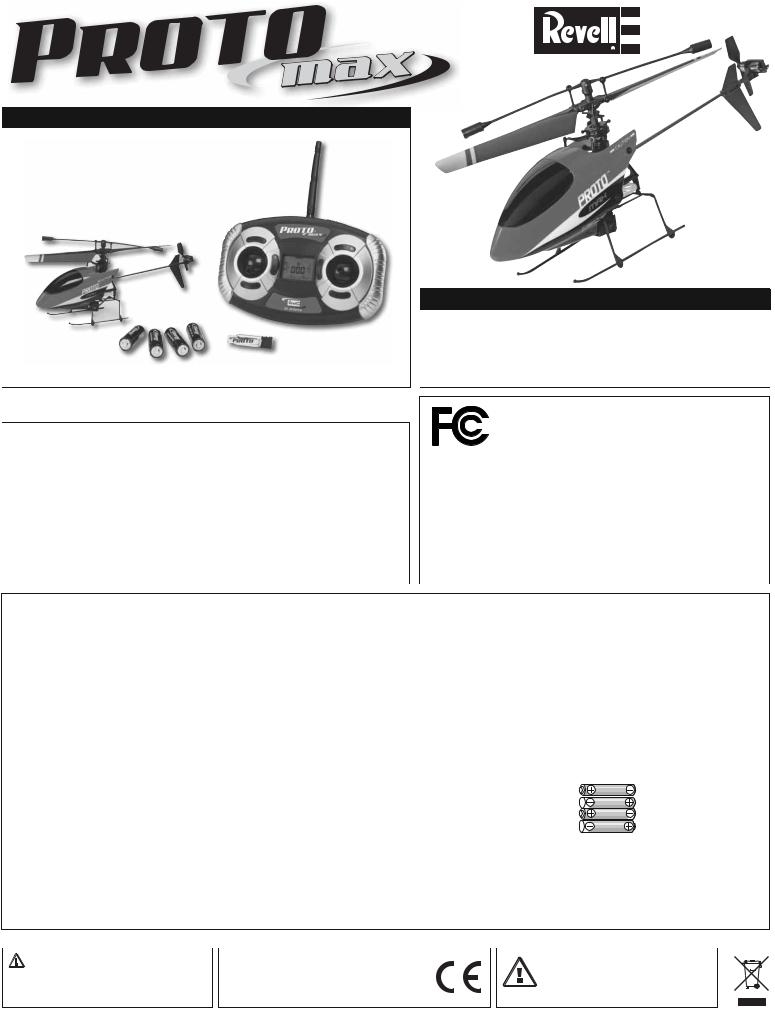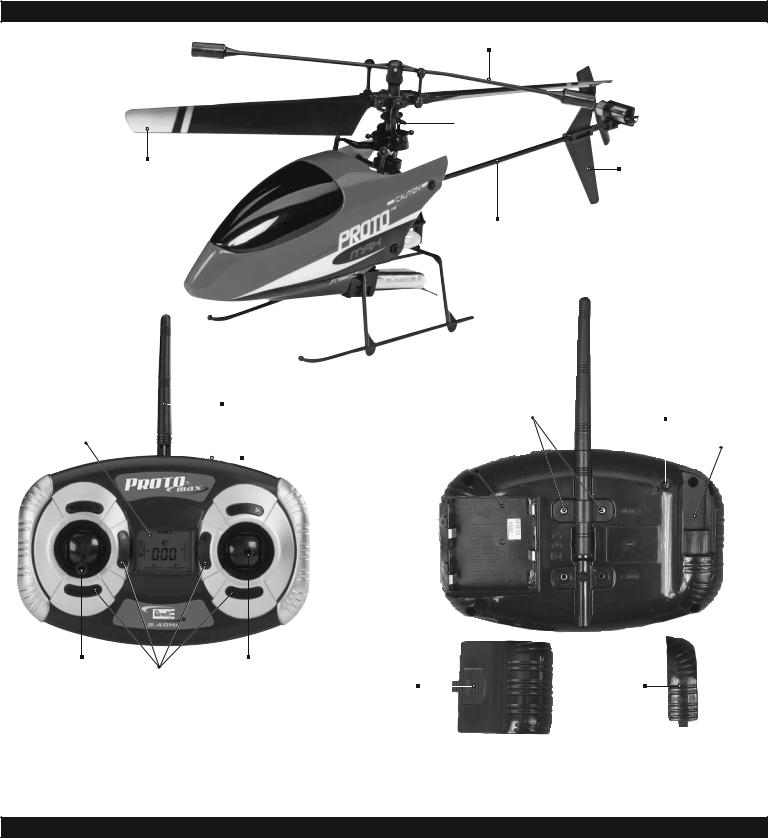REVELL Proto Max Ready-to-Fly Helicopter User Manual [en, fr, nl, it, gr, da, no, fi, sv, es, pt, de, en, hr, et, fi, hu, lv, lt, nl, pl, ro, ru, sr, sk, sl, cs, tr, gr, bg, uk, ch, he, ar, ja, ch, ch, ko, hi, id, kk, ms, fa, pt, es, th, vi, sq, mk]

™
Contents
Proto Max |
|
2.4GHz Transmitter |
|
Four “AA” Alkaline Batteries |
3.7V 130mAh |
|
LiPo Helicopter Battery |
|
|
|
Do not touch the spinning blades or fly over another person’s head. Adult supervision is required.
Safety Precautions:
Warning: Do not modify or alter this unit. Changes or modifications to this unit not expressly approved by the party responsible for compliance could void the user’s authority to operate the equipment.
•Do not turn on the Proto Max helicopter unless the controller has been turned on first.
•Keep hands, hair and loose clothing away from the spinning blades.
•Turn off the controller and Proto Max when not in use.
•Remove the battery from the controller when not in use.
•Parental guidance is recommended while flying.
•Always keep your Proto Max in sight while flying.
•For the best performance, use new alkaline batteries in the controller.
•Replace the batteries in the controller with new ones as soon as any function becomes diminished.
•Keep these instructions for future reference.
•Follow the operating instructions exactly.
•Your controller’s built-in charger is made specifically for the rechargeable Proto Max LiPo battery. Do not use it to charge any other battery.
www.revell.com
Revell, Inc.
Elk Grove Village, IL 60007
Main Features
•Full, four-channel control
•Interference-free 2.4GHz operation
•Interchangeable Mode 1 or Mode 2 configuration
•Built-in LiPo battery charger
•Computer display screen
FCC REQUIREMENT
NOTE: This equipment has been tested and found to comply with the limits for Class B digital device, pursuant to part 15 of the FCC rules. These limits are designed to provide reasonable protection against harmful interference
in a residential installation. This equipment generates, uses and can radiate radio frequency energy and, if not installed and used in accordance with the instructions, may cause harmful interference to radio or television reception, which can be determined by turning the equipment off and on. The user is encouraged to try to correct the interference by one or more of the following measures:
•Reorient or relocate the receiving antenna.
•Increase the separation between the equipment and receiver.
•Connect the equipment into an outlet on a circuit different from that to which the receiver is connected.
•Consult the dealer or an experienced radio/TV technician for help.
Care and Maintenance:
•Always remove the batteries from the controller when it is not being used for a long period of time.
•Wipe the toy gently with a clean, damp cloth.
•Keep the toy away from direct heat.
•Do not submerge the toy into water. This could damage the electronic assemblies.
Adult supervision is required.
This device complies with Part 15 of the FCC rules. Operation is subject to the following two conditions: (1) This device may not cause harmful interference, and (2) this device must accept
any interference received, including interference that may cause undesired operation.
Battery Cautions:
•Do not power the controller by mixing different types of batteries, or old and new batteries.
•Use only batteries of the same or equivalent type as those recommended.
•Install batteries following the correct polarity.
•Do not short-circuit the supply terminals.
The Proto Max is equipped with a rechargeable LiPo battery. Please pay attention to the following cautions for safe use:
•Do not dispose of the battery into fire or heat.
•Do not use or leave the battery near a heat source, such as fire or a heater.
•Do not strike the battery or throw it against a hard surface.
•Do not immerse the battery into water. Keep the battery cool and dry.
•When recharging the battery, use only the charger designed for that purpose.
•NEVER leave the battery unattended while charging.
•Do not over-discharge the battery.
•Do not connect the battery to an electrical outlet.
•Do not directly solder the battery or pierce it with a nail or other sharp object.
•Do not transport or store the battery together with metal objects such as necklaces, hairpins, etc.
•Do not disassemble or alter the battery.
•Turn off your equipment power switch after use.
•Recycle used batteries after covering the battery terminals with insulation tape or inserting the battery into an individual polybag.
Note:
•Parental guidance is recommended when installing or replacing batteries.
•Static electricity may cause the toy to malfunction, requiring you to turn it off and back on before flying again.
Note Specifically for Adults:
•Regularly examine all parts of the toy for damage. If any is found, do not use the toy again until the damage has been repaired.
•This toy is not intended for children under 8 years old.
•This toy must be used only with the recommended charger.
•Do not try to charge other batteries with the controller’s charger.
Battery Requirement for Proto Max:
Requires: 3.7V LiPo Rechargeable Battery Pack (included and installed)
Battery Requirements for Controller:
Requires: 4 x 1.5V “AA” size batteries (included)
CAUTION: Changes or modifications to this product not expressly approved by the party responsible for compliance may void the user’s authority to operate the equipment.
WARNING:
CHOKING HAZARD — Small parts. Not for children under 3 years of age.
“This product is in compliance with the essential requirements and other relevant provisions of Directive 1999/5/EC.”
Do not touch the spinning blades or fly over another person’s head. Adult supervision is required.

Proto Max and Controller Parts
Stabilizer bar
 Main shaft
Main shaft
Rotor blades |
Tail fin |
Canopy 

Tail boom
Landing gear 

|
|
|
Transmitter antenna |
Antenna mounting screws |
Charge indicator light |
||
|
|
|
|||||
|
|
|
|
|
|||
Status display screen |
|
|
Battery charge port |
||||
|
|
||||||
|
|
|
|
Power/charge switch |
|
|
|
|
|
|
|
|
|
|
|
|
|
|
|
|
|
|
|
Battery compartment

Throttle/yaw |
Trim buttons |
Pitch/roll |
Battery |
|
|
control stick |
control stick |
|
Battery charge |
||
|
compartment |
|
|||
(Mode 2) |
|
(Mode 2) |
|
port cover |
|
|
cover |
|
|||
|
|
|
|
|
Find a Suitable Flying Area
Before preparing your Proto Max for flight, now would be a good time to think about where you are going to fly it. Experienced pilots may have the skill to fly in confined areas with obstacles (such as a living room or garage), but beginners should find a larger area with a smooth floor free from obstacles (such as a gymnasium or a large basement with a tall ceiling). If the winds are calm, experienced pilots may also be able to fly the Proto Max outdoors, but even the slightest wind will make it too difficult for beginners.
Now that you have identified a suitable flying area, there are a few procedures that must be followed to prepare your Proto Max for flight.
2

Install the Transmitter Batteries
Remove the battery compartment cover from the back of the transmitter. Install four AA batteries according to the “+” and “–” polarity markings imprinted into the battery compartment. Replace the cover.
Flying mode
Battery icon
Turn on the power/charge switch on the transmitter and observe the battery icon in the status display. When the battery icon is blinking, the batteries are too low and should be replaced. Four squares inside the battery icon indicate that the batteries are at full power.
Also note the flying mode in the status display and make sure your transmitter is configured in the desired mode.
Charge the LiPo Helicopter Battery
The LiPo (lithium polymer) helicopter battery usually takes approximately one hour to charge. This may seem like a long time, but due to the powerful chemistry of LiPo batteries they must be handled with great care and cannot be charged too quickly. The maximum charge rate of a LiPo battery is 1C, or one times capacity. Since the capacity of your LiPo helicopter battery is 120mA (120 mili Amperes), and the charging system in the transmitter charges the helicopter battery at approximately 130mAh (130 mili Apmeres per hour), this works out to one hour for charging time. Even the most powerful LiPo batteries in super-expensive radio controlled models cannot be charged faster than 1C without possibly causing damage. Actual charging times for your battery will depend on how much the LiPo battery was discharged from flying and the condition of the four AA batteries in the transmitter. Please note: Your LiPo battery arrives in a protective case. Always store and carry your LiPo battery in this protective case.
CAUTION: LiPo batteries must ALWAYS be handled with extreme caution. Never place the LiPo helicopter battery in your pocket or in your tool box where the contact tabs could inadvertently be connected to each other via. coins, keys, tools or any other
metallic objects. If anything metallic happens to complete the circuit across the contact tabs—even if just for a fraction of a second—the batteries will likely be damaged and could become hot enough to burn or even cause a fire.
With the transmitter on, remove the battery charge port cover and fully install the rechargeable LiPo helicopter battery—note that the exposed contact tabs face toward the front of the transmitter. Make certain the green charge indicator light is glowing, indicating that the battery is being charged. Note: The power/charge switch must be “on” to charge the batteries.
Monitor the charge indicator light. Note when it goes out, indicating that charging is complete. Remove the battery. If not flying immediately, turn off the transmitter and set the battery aside, noting all battery precautions written in the front of this instruction manual.
3
